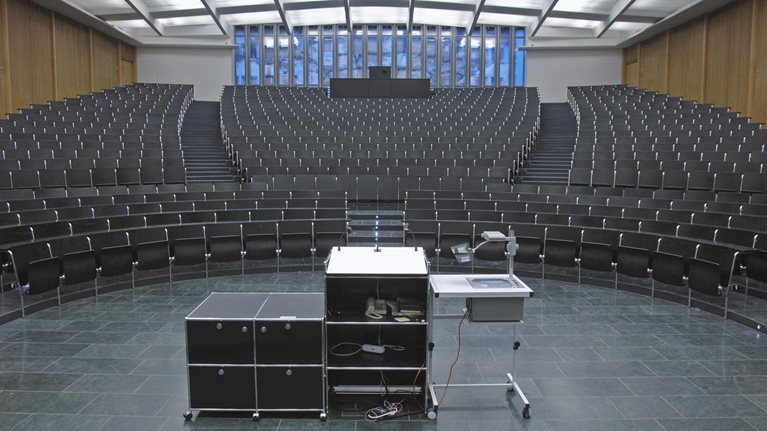The COVID-19 challenge is unprecedented; its scale still is not understood. Colleges and universities in the United States cannot know when they will open again to normal activity or to what extent education as usual will resume. But even though higher-education leaders cannot know the answers, given the uncertainty in the epidemiological and economic outlooks, they must start asking themselves questions about the medium- and long-term implications for teaching, learning, the student experience, infrastructure, operations, and staff. Disciplined scenario planning can help.
In this article, we consider three broad epidemiological and public-health scenarios (Exhibit 1). All of these represent a degree of economic disruption few adults in the United States have ever experienced.

In the first scenario (virus contained), COVID-19 is contained in the next two to three months. In the second, more pessimistic scenario (virus recurrence), physical distancing and other restrictive measures last in some regions for several more months. In the final, most extreme scenario (pandemic escalation), the public-health response fails to control the spread of the virus for an extended period of time, likely until vaccines are widely available.
On the basis of these scenarios, we examine different ways in which the COVID-19 crisis could play out for US higher education (part 1). Then we suggest how institutions could respond to the unfolding conditions in both the near and medium terms (part 2).
Part 1: How the scenarios could play out for higher education
The only certainty is uncertainty. However, given the mission and function of universities, they need to examine the possibilities across everything they do.
Implications for teaching and learning
In the virus-contained scenario, we envision that most students will complete the current semester online, and the class of 2020 will graduate virtually—that is, without a formal on-campus ceremony. Beginning in the summer, rules on travel and events will loosen to some extent, although study-abroad programs might not resume just yet. Although additional health safeguards will be necessary, students will be able to return to class for the fall semester. However, restrictions will remain for some international students, and many members of the incoming class will have had disruption in the last months of their high-school educations.
Even this relatively optimistic outlook is likely to pose significant challenges to higher education. The sudden shift to online learning is already stretching existing infrastructure; faculty with little or no experience in teaching in this environment may struggle. Courses with a high level of hands-on components—such as clinical practicums, labs, and performing arts—will be particularly disrupted, and students in these fields may have to delay graduation to fulfill requirements. Exams will have to be held online, making it impossible to administer closed-book tests.
In the other two, more pessimistic scenarios, most schools will be exclusively online through 2020 and into 2021. Travel will be greatly limited, and large events will not take place. Study-abroad programs will be canceled through 2021. The incoming class of first-year students will start college without an on-campus orientation. Faculty will have to make longer-term changes to their curricula and teaching approaches. A notable share of the class of 2021 will not graduate that year.
Implications for student enrollment, equity, and experience
In the virus-contained scenario, the main impact will be on persistence, as students and faculty will struggle to adapt to online coursework. Institutions with limited records of creating a compelling online experience could be hurt if their current students are dissatisfied with their digital offerings and decide to go elsewhere. Students might also delay returning until campus life is back to something close to normal.
In terms of equity, lower-income students will suffer disproportionately. They are less likely to have the resources, such as PCs and high-speed-internet access, to enable them to succeed in an online-learning environment. They will also face the most immediate financial challenges, with many industries laying off employees and on-campus employment mostly ended.
As for the student experience, hunkering down at home with a laptop and a phone is a world away from the rich on-campus life that existed in February.
In the virus-recurrence and pandemic-escalation scenarios, higher-education institutions could see much less predictable yield rates (the percentage of those admitted who attend) if would-be first-year students decide to take a gap year or attend somewhere closer to home (and less costly) because of the expectation of longer-term financial challenges for their families. International enrollment could be severely hit because of ongoing travel restrictions and fear. Both trends would depress enrollment.
On the other hand, higher-education enrollment has traditionally increased during recessions. For example, during the global financial crisis of 2008–09, US undergraduate and graduate enrollment grew by about 5 percent and 10 percent a year, respectively, until 2011, netting a trough-to-peak addition of almost three million students.1 There could also be a rebalancing of students between schools. Specifically, schools that are more affordable and those that have a strong, well-developed online-learning infrastructure could see enrollment rise. Almost half of US colleges and universities had no formal online-education programs in 20182 ; they may find it more difficult to attract and keep students.
Implications for faculty and staff
In any scenario, faculty will be under intense pressure to develop and deliver online courses. Beyond that, cancellation of kindergarten through 12th grade could affect faculty members with children and compromise the availability of staff services. Mental-health resources could see greater demand. And with campuses shut down, it would not be easy to know what to do about staff whose services are not needed as much but who are members of the community and rely upon that income.
In the virus-recurrence scenario, scientific and medical research will be difficult to continue, and a poor economy would likely mean fewer grants. Finally, even if downsizing has been avoided through the summer, it may become inevitable in this scenario. Many higher-education institutions simply will not be able to keep paying all their personnel in full when there are no students on campus.
Implications for infrastructure
In the few cases in which students remain on campus, they need to be kept healthy and physically distanced. Even when there are few or no students around, universities must continue to support faculty and staff. In both cases, campus health systems may be feeling the stress. Universities with academic medical centers are on the front lines of care for their communities. If the number of COVID-19 cases requiring intensive care and ventilators rises steeply, academic medical centers could find themselves in dire straits.
In the virus-recurrence and pandemic-escalation scenarios, dorms and other infrastructure will remain empty through 2020 or beyond. In both scenarios, that infrastructure might be used by healthcare authorities for medical staff or for quarantine. Meanwhile, IT infrastructure will need upgrading, including the integration of new learning software and tools to maintain teaching standards, as courses move online.
Implications for finances
For most colleges and universities, COVID-19-related developments will put their budgets under even more pressure. In the virus-contained scenario, current-year tuition revenues will likely fall, given refunds for study-abroad programs and the likely reduced persistence of students. Also, because online programs have traditionally been cheaper, universities are already facing calls to refund portions of regular tuition. Next year will likely see fewer international students enrolled. Auxiliary revenues (room, board, athletics, rentals, grants, and other nontuition revenue sources) will erode as refunds or vouchers for next year are issued for housing, meals, and parking—and if summer programming is disrupted or canceled.
In the virus-recurrence scenario, the situation would be worse for both tuition and nontuition revenues. Tuition revenues will dip for many schools, with reductions in international-student enrollment, cancellation of study-abroad programs, and increases in attrition, especially for schools with limited online-delivery capabilities. Nontuition revenues will also remain low, with all large events and conferences postponed and fall sports canceled. Fundraising will also be challenged in the context of a broad economic downturn. If the stock market stays weak, the value of endowments will fall.
In the pandemic-escalation scenario, all of those pressures will intensify further as the duration of online learning extends.
To understand better how the unfolding COVID-19 pandemic could affect the economics of higher education, we constructed an economic model, based on how long online programming remains the primary operating model (Exhibit 2).

Even under the more modest virus-contained scenario, 25 percent of public four-year institutions and almost half of private not-for-profit four-year institutions could suffer budgetary shortfalls of more than 5 percent, absent a public or philanthropic intervention. In the pandemic-escalation scenario, the percentage of US higher-education institutions experiencing budgetary shortfalls of more than 5 percent will increase to more than half. For private not-for-profit four-year colleges, that percentage will rise to 77 percent. In addition, more than 800 higher-education institutions of all kinds could suffer a 20 percent or greater budgetary shortfall (assuming costs stay the same). Some will be able to deal with the shortfall by drawing capital from their endowments; one out of three private not-for-profit schools with a 5 percent budget shortfall could cover it with draws of up to 10 percent of their endowments. That, however, is a stopgap, not a strategy (see sidebar, “COVID-19 and historically black colleges and universities”).
Part 2: What colleges and universities can do
Higher-education institutions in the United States have already taken dramatic first steps to keep their people safe and to keep learning alive. Here are some other actions they can consider in the weeks and months ahead:
- Now: Set up a nerve center. An integrated nerve center can help higher-education leaders plan and manage their response to COVID-19 by establishing work teams with specific areas of responsibility. The work has four parts. First, discover an accurate view of the situation—on campus, in virtual classrooms, and in the broader community—and derive implications from that view. Second, decide what to do quickly—but after stress-testing hypotheses and alternatives and ensuring adherence to university and local community values. Third, design a portfolio of actions—for both the short and long terms—with a pragmatic operating model, to develop detailed plans and act on them. Finally, deliver plans and responses in an efficient, flexible manner. Nerve centers must meet regularly—at least once (and better, twice) a day—and enforce accountability by tracking what is being done, when, and by whom.
- Near term (April to May): Focus on students, financial resilience, and support of faculty and staff. Start with ensuring that students have all necessary assistance, including mental-health services, and that educational standards are maintained. Faculty should receive the support required to continue their research and to learn how to teach effectively in an online environment. For nonessential staff, make quick decisions about sick-pay and employment policies. Finally, institutions must figure out where they are with their finances. Given the continued uncertainty, they should evaluate a range of scenarios, and seek to understand their sensitivities to certain revenue streams. We will expand on specific actions to consider in future articles.
- Medium term (June to September): Focus on enrollment, persistence, and operations. Institutions should plan for the next school year. Establish a command center to manage yield actively, particularly regarding students at higher risk of not enrolling, such as international and lower-income students. Universities should also consider whether and how to make significant changes to current teaching models, making them more scalable, more flexible, lower cost, and, importantly, more engaging. They also need to plan for appropriate remediation for the significant disruptions to teaching and learning that all students will have experienced.
Crises can create paralysis and fear. Rigorous scenario planning can help leaders map the potential damage and devise ways to deal with it. Universities need to look beyond the immediate crisis to create effective long-term strategies both to get through the present and to safeguard their futures in the new normal that will follow.


